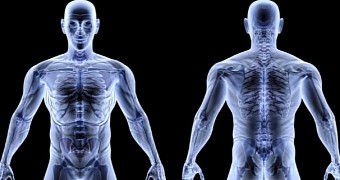A recent study in the journal Science Translational Medicine offers new insights into a rare condition that turns muscles, tendons, ligaments and other soft tissues in the body into bone.
The disorder, officially called fibrodysplasia ossificans progressiva (FOP) but more commonly referred to as the stone man syndrome, is the result of a genetic mutation.
By progressively transforming soft tissues into bone, what it does is turn the body into just one big skeleton. People become immobilized, imprisoned by their own body, and eventually die.
The condition affects 1 in every 2 million people, with 800 cases now confirmed across the globe. Still, specialists say other cases probably haven't been discovered yet.
At birth, patients display malformed big toes. As they age, the soft tissues in their neck and shoulders ossify. Then, the condition progresses to the rest of their body and their limbs.
As their joints become bone, people suffering from this condition become immobile. In extreme cases, their rib cage becomes stiff, and so they can no longer breathe.
It can also happen that, as the muscles, tendons and ligaments in their jaw ossify, they lose their ability to speak. Sometimes, they can no longer open their mouth to feed.
Surgery is not an option as, when the bone growths are removed, it doesn't take long for others to take their place. Besides, swelling or inflammation makes things worse, prompting more soft tissue to be replaced with bone.
A possible cure
In their report in the journal Science Translational Medicine, a team of researchers working with NY-based biopharmaceutical company Regeneron Pharmaceuticals Inc. explain that the stone man syndrome appears to be caused by mutations in a gene called ACVR1.
This gene is known to be involved in bone and muscle development. Usually, its activity is kept on a tight leash by a signaling protein called activin A, Medical Express explains.
In the case of people diagnosed with this rare condition, however, the protein fails to inhibit the gene's function. Instead, what it does is push it into overdrive.
In a series of experiments, the scientists administered mice genetically engineered to display stone man syndrome symptoms an antibody designed to keep the activin A signaling protein from activating the gene linked to this condition. Apparently, the treatment worked.
Thus, for 6 weeks following administration, the rodents no longer had bone replace the soft tissues in their body. Besides, no serious side effects were documented.
As least for now, it is unclear whether a clinical trial involving human patients will follow anytime soon. Nonetheless, the researchers and the biopharmaceutical company seem quite pleased with the results of their experiments. Others seem to have faith in this study too.
"We are very fortunate and grateful that not only did Regeneron make this basic science discovery, but that, as a biotechnology company with expertise in developing antibodies, they are in a position to act on it and answer the next questions about whether this could lead to a meaningful therapy,” said Betsy Bogard with the International FOP Association.

 14 DAY TRIAL //
14 DAY TRIAL //